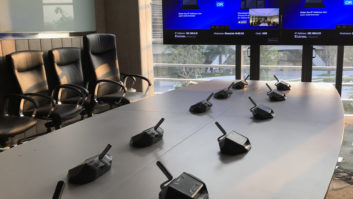
In the first part of this feature on conference venues we discussed the healthy level of demand for AV providers. Here we look at some of the developments in the market and consider the need for audio-based systems to accommodate non-audio features.
Facilitating fast and hassle-free audience participation is a common theme among the audio manufacturer community when discussing the innovations that are helping them to maintain market presence. Running parallel with this is an acknowledgement that conference systems should be as easy to integrate as possible into what may be decidedly complex configurations.
Sennheiser has been a key player in the conference audio market since 1976. For Jans Werner – who is portfolio manager business communication and responsible for product management for all of Sennheiser’s conference solutions, including SDC, ADN and TeamConnect – there are presently “trends in different directions: one is to integrate multimedia functionality into these kind of systems; another is to offer reduced-to-the-minimum entry-level systems which don’t distract the end-user with unnecessary features”.
Looking forward, Werner expects a greater requirement to support attendees bringing their “own devices into conference venues and using them for local information as well as audio content. We have followed this trend with our MobileConnect system.”
One of Sennheiser’s latest introductions for the conference market, MobileConnect delivers live audio streaming in real time on a smartphone via an app. This means that it can be used “as an assistive listening or language distribution system in conferences, while being a cost-effective solution for the host (no need to rent and clean devices), and an easy-to-use and comfortable solution for the end-user who can deploy his/her own smartphone and headphones.”
A Dante-supporting network audio microphone range is among the newest introductions to the market from Audio-Technica. Mirroring Audio-Technica European marketing manager pro-audio Tom Harrold’s assertion that “the merging of AV and IT are likely to be key trends in the coming years”, the company last year unveiled ATND971 – described as being the world’s first Dante-enabled wired microphone.
“A simple Ethernet connection allows the network mic to communicate across an existing network of Dante-enabled devices and, with the microphone’s programmable user switch, control any of those devices at the push of a button,” he says.
With different types of new functionality coming onstream, the onus is simultaneously on manufacturers to reduce stress levels for integrators, customers – and perhaps especially, conference attendees. “As technology becomes more complex and offers increasing functionality, it’s equally important for manufacturers to work to preserve usability for conference delegates,” says Harrold. Accordingly, “products such as the ATND971 are designed to offer real flexibility without sacrificing ease of use for untrained users. This allows venues to offer systems with high levels of control without burdening delegates with daunting technology.”
Accommodating variable levels of end-user knowledge is one overriding theme. The same goes for flexibility – and in particular, the apparent need to configure and reconfigure meeting spaces for a host of different gatherings. In this regard, digital wireless audio systems can prove to be a significant asset, implies Shure Distribution head of Systems Group Duncan Savage.
“The requirement for multipurpose divisible spaces has increased the demand for robust wireless audio conferencing solutions such as [Shure’s] Microflex Wireless and ULX-D [Digital Wireless] systems – these are both digital platforms operating in the DECT and UHF bands, respectively,” explains Savage.
Ease of monitoring is another important consideration; for example, with Microflex Wireless, there is the ability to benefit from “networked monitoring and control of large systems up to 64 channels, [while] frequencies are co-ordinated automatically by the access point, avoiding sources of interference.”
Non-audio features?
Opinions vary on the desirability of primarily audio-based systems to accommodate non-audio features. Certainly, Sennheiser doesn’t seem too keen, with Werner stating that “we don’t believe that this kind of feature combination is really helpful for the end-user. It distracts from the main audio functionality”.
Others feel differently – and document sharing, in particular, is destined to be a focus of extra feature development. For example, document management is already a component of Shure’s DCS6000 and SW6000 delegate system. “Delegates attending a conference using DCS6000 conferencing hardware and the supplementary SW6000 package are able to view documents, open hyperlinks and browse the internet when using the Conference User Application,” says Savage. “The demand for content sharing in conference systems is definitely going to increase as users request the ability to share information from their own devices using the same infrastructure as the conferencing hardware.”
The recent auction of RF frequencies across Europe – and the prospect of more reallocation to follow over the next few years as regulators struggle to satisfy mobile service providers’ seemingly unquenchable appetite for spectrum – means that wireless conference systems manufacturers may well have their work cut out just ensuring basic operating reliability without heaping on too many additional features. But whatever the technical challenges, a consistently robust European market as well as emerging economies promise to keep order books healthy for wired and wireless solution providers alike.
Pointing to two regions in particular, Harrold concludes: “The Middle East and African markets show rapid growth in conferencing. As their economies continue to develop and infrastructures expand, so does the demand for conferencing solutions.”







